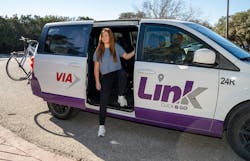VIA Metropolitan Transit’s VIA Link to expand Oct. 23
VIA Metropolitan Transit is launching its newest VIA Link on-demand zone on Oct. 23, 2023. VIA’s fourth VIA Link zone, “VIA Link Randolph,” will provide service connecting an 18-square mile area with connections to Randolph Transit Center, Planned Eastside Mobility Hub, Artisan Apartments, and JBSA Fort Sam Houston Brooke Army Medical Center. The new zone improves service and expands access to employment hubs.
“This is the next step in fulfilling our promise to expand our services and offer our customers more mobility options that help them connect with opportunity,” said VIA President and CEO Jeffrey C. Arndt. “The on-demand service model offered by VIA Link is convenient, affordable and innovative. It provides a more efficient travel option for our customers.”
VIA Link service replaces fixed routes in the zone, with more frequent service for the same fares as regular bus service, only $1.30 per ride. The VIA Link service’s high ridership in the Northeast, Northwest and South zones has increased customer demand. Each of the four zones will have new names and expanded service hours:
- VIA Link Randolph: Every day from 5 a.m. – 10 p.m.
- VIA Link Mainland (formerly Northwest zone): Every day from 5 a.m. – 9:30 p.m.
- VIA Link Madla (formerly South zone): Every day from 5 a.m. – 9:30 p.m.
- VIA Link Naco Pass (formerly Northeast zone): Every day from 5 a.m. – 9:30 p.m.
Customers can book trips using a free app, online portal or by phone and are usually picked up within 10 to 20 minutes of booking — an improvement from the current wait times on bus service — and can track and rate their rides. Passengers can travel anywhere in the zone or to convenient transfer points to connect with the full VIA system. The flexibility provides better frequency and decreased travel times, minimizes walking distances and offers more pick-up and drop-off locations.
Expanding on-demand service is part of VIA’s Keep SA Moving plan that was overwhelmingly approved by voters in November 2020. It’s part of a plan to provide smart transit options, using technology and partnerships for better service.



